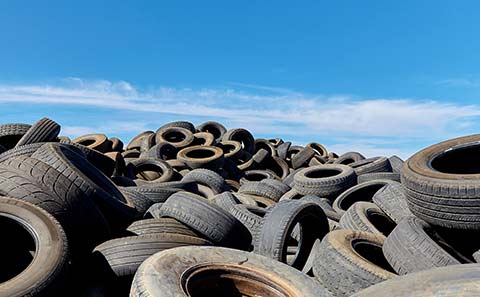If you have a classic car, or even one that’s been out of production awhile and isn’t yet considered a classic, you may want a tire that looks older. Period tires or reasonable facsimiles go a long way in making a classic car look period-correct.
Is it a good idea to buy really old tires? Usually, no. If you show your car, however, having period-correct tires—even if you mount them on the car just before the show, and even if you have inner tubes installed so they are airtight—can earn you points.
Period-Correct Tires for Show

If you’re buying old tires for show, the important thing is buying a tire that’s still sound. Tires 10 or 15 years old can be dry rotted and brittle, and they can separate at speed. You really don’t want to drive them on the highway, but they can do very nicely at a car show or concours, where speeds off the trailer and distances are limited.
You can sometimes find older tires appropriate for showing at Best Used Tires. The availability for such tires ebbs and flows. You simply have to check.
Authentic-Looking Tires for the Street

If you drive your baby—a ’60s Mustang, maybe, or a ’70s Corvette—and show it at shows that are less than concours level, you may want to consider today’s cosmetic performance tires. They look the part, some with raised white letters and an appropriate profile. Plenty are available used.
They’re often speed-rated S, to 112 miles per hour, or T, to 118. Keep this in mind: They probably perform better than many tires available to your newer classic when it first came off the showroom floor.
Another option is to have a modern radial made to look like a vintage tire. Diamond Back Classic Radials of Conway, SC, vulcanizes older-style white-, red- or blue-stripe sidewalls onto new brand-name radials. The tread gives away the tire’s modernity, but from the side, the tire looks like one from an earlier era. You can drive these tires, which are speed-rated and reliable.
Modern Tires that Look Old
Several companies manufacture new tires in styles from the 1930s, ’40s or ’50s, or even from the early 1900s. Typically whitewalls are wide and shoulders don’t wrap around the edges. Some are modern radials that are safe, fast and stable but cloaked in old looks.
Coker Tire, Chattanooga, TN, manufactures a range of sizes in reconditioned Firestone Deluxe Champion molds. These bias-ply whitewall tires were ubiquitous on American cars in the 1940s and early to mid-1950s, and on some collectible BMWs and Mercedes. Coker’s similar BF Goodrich Silverstone tires—also bias ply like the originals—fit cars back to the early 1900s. Coker Classic tires come in a variety of whitewall and tread widths. Its Excelsior tires are radials that replace narrow bias tires.
Coker also manufactures bias/belted Firestone Wide Oval tires, original equipment on many 1960s and early 1970s muscle cars and pony cars. Somewhat more modern muscle car tires are BF Goodrich Radial T/As, which Coker also makes from reconditioned molds. It sells red line, thin whitewall and classic raised white letter versions of both tires.
Universal Vintage Tire Co., Hershey, PA, sells new tires made by several companies to fit older cars. Some are made on reconditioned molds, including Goodyear bias/belted Polyglas tires, to fit ’50s and ’60s performance cars, and lines for imports and antiques.


